
by Daniel J. Leonard | Dec 4, 2025
My previous article outlined the benefits of planting trees during the winter dormant season. Once planted, it’s then time to implement one of the best practices that helps ensure successful establishment of recently installed trees and shrubs – mulching.
Mulching, by definition, is simply the process of adding a layer of material over the top of the soil. Like planting at the right time, mulching does many great things for your landscape. Mulching helps moderate temperatures; the soil stays warmer in the winter and cooler in the summer. Mulching increases water retention; when the sun isn’t blasting directly onto the soil, it dries out much more slowly. Mulching reduces weed pressure; most weed seeds require sunlight to germinate. Etc. Etc. The benefits of mulch abound. But what material you use and how you apply mulch figure heavily into whether your mulch helps or harms the plants whose roots it lies over.

Pine bark mulch applied correctly in a landscape. Photo courtesy of Daniel Leonard.
There are two basic options when considering mulch: organic or inorganic sources. In general, you should always select an organic mulch that is derived from local sources. Organic mulches are mulches derived from natural materials like pine straw, leaves, tree bark, or shredded wood chips. These mulches break down over time and benefit soil health through bettering water holding capacity, increasing soil porosity and organic matter content, and drastically expanding the soil biome (beneficial worms, fungus, and bacteria that live in the soil). Organic mulches also allow landscapes to blend in with the natural areas surrounding homesites as they typically use materials found in local ecosystems. For example, in the coastal south, pine forests dominate, pine straw is plentiful, and purchasing usually supports local businesses that grow, harvest, and market the straw. So, unless you happen to live in a desert environment where rocks are natural, steer clear of rocks or other inorganic mulches.

Pinestraw mulch applied around a newly planted tree. Photo courtesy of Daniel Leonard.
As with most things, there is a Goldilocks zone for mulch. Too little isn’t enough to keep weeds from easily poking through and soil from quickly drying. Too much and you risk depriving plant roots from oxygen exchange with air above, trapping too much moisture and causing rot issues, or even creating a hydrophobic layer of dried mulch that repels rainfall and irrigation. Instead, just the right amount of mulch should be applied, enough to create a 2-3” layer of helpful mulch. With some mulches like straw, this may mean applying a 6-8” layer that will settle down to the magic 2-3” number with a good rain, interlocking the individual pieces of straw. With others like wood chips or bark nuggets, there will be little settling, and the applied amount should be 2-3” deep. A final tip is to always pull mulch back a little from the crowns of plants and the trunks of woody trees and shrubs to prevent potential disease issues.
So, after you install your new landscape plants this winter, remember to mulch well. Be sure to select an organic mulch that supports local industries, enhances the soil in your landscapes, protects your plants’ roots, prevents weeds, and looks natural! For more information about mulch or any other horticultural topic, contact your local UF/IFAS County Extension Office. Happy Gardening!
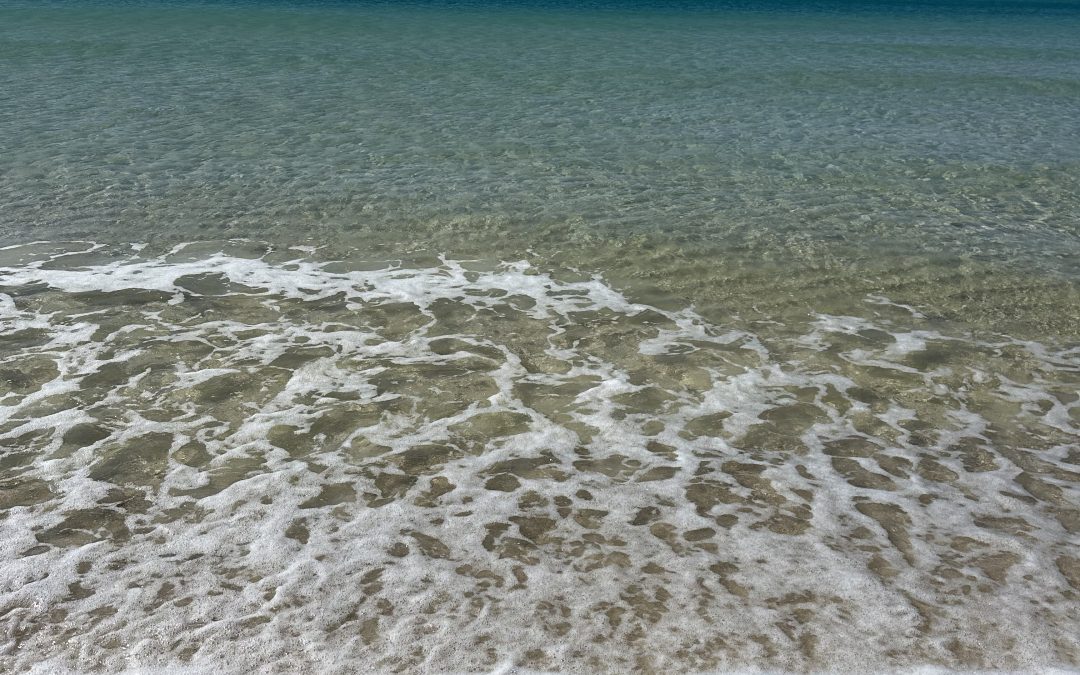
by Lauren Goldsby | Dec 4, 2025
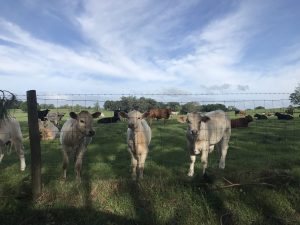
Agriculture is not the first thing that comes to mind when you’re in Bay County, especially when you’re enjoying a day at the beach! In the 2022 Census of Agriculture, 139 farms were reported, covering more than 70,324 acres. Much of what’s counted as farmland in Bay County is forested land managed for timber rather than traditional row-crop agriculture. Other commodities include hay, berries, livestock, honey and aquaculture. Together, agricultural sales generated $3.69 million dollars in 2022. Agriculture exists here, but it is not the primary economic driver. Tourism plays a much larger role, bringing $3.1 billion in visitor spending and supporting over 35,000 jobs.
This can be a common in areas where there is a large amount of tourism. Both systems depend on healthy natural resources, for different but equally important reasons. This is especially true when it comes to water, which makes up 27% of the county by area. Large scale producers use Best Management Practices (BMPs) to reduce the amount of chemical and nutrient runoff into our water systems.
If an area does not have a lot of agriculture does that mean we are safe from pollution in our water? No. Runoff isn’t just a problem in agricultural systems. A single lawn may not contribute much on its own, but when you add them up they can become a significant source of water pollution.
One of the easiest ways you can reduce impacts on our water resources is with how you fertilize your lawns. Here are some residential BMPs you can follow in your own yard. If you are fertilizing next to a body of water, leave a 10-foot strip unfertilized on the water’s edge. Don’t apply more than 1 pound of slow release nitrogen per 1,000 square feet at a time or exceed 4 pounds per 1,000 square feet per year. If you are using a quick release nitrogen do not apply more than ½ pound at one time for the same area. This chart below can be used to calculate how much fertilizer that is based on the percent of nitrogen. Nitrogen is always the first number, followed by phosphorus and potassium. Remember that right now your lawn doesn’t need any fertilizer. Dormancy is a protection from winter freezes, and fertilizer put out now will not be taken up effectively by dormant grass.
| Nitrogen percent in fertilizer |
Pounds of fertilizer to apply 1lb of nitrogen / 1000 sqft |
| 5% |
20 lbs |
| 10% (10-10-10) |
10 lbs |
| 20% |
5 lbs |
U.S. Department of Agriculture, National Agricultural Statistics Service. (2022). 2022 Census of Agriculture, Bay County, Florida. https://quickstats.nass.usda.gov/
Bay County Chamber of Commerce. (2025). Business & community profile. https://panamacity.org/tourism-business/
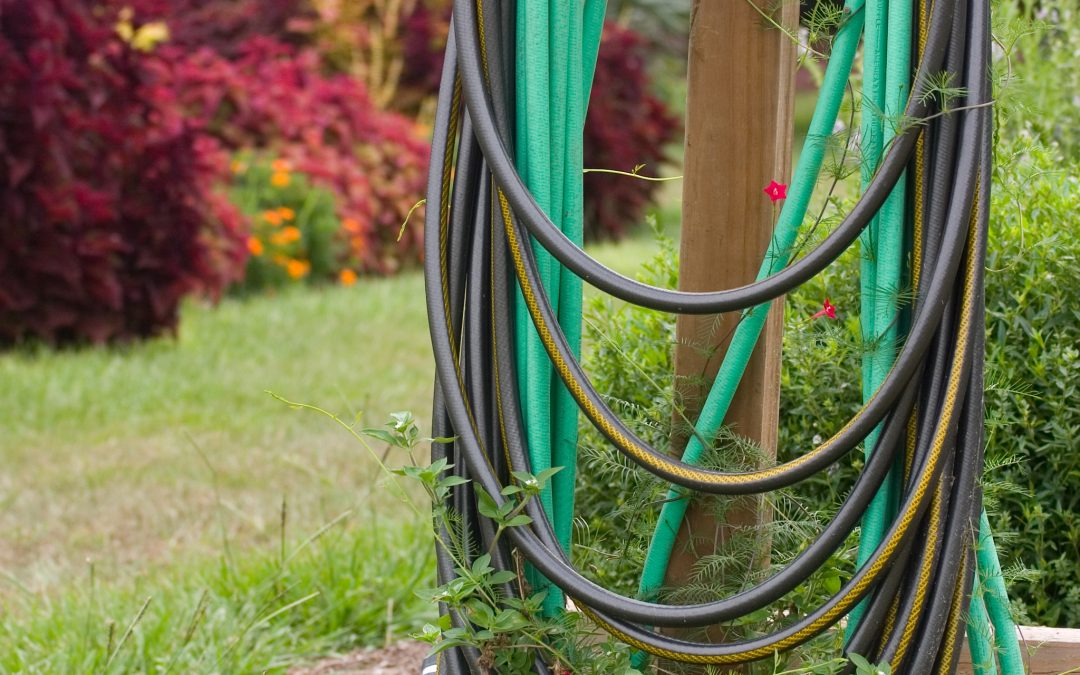
by Mark Tancig | Nov 13, 2025
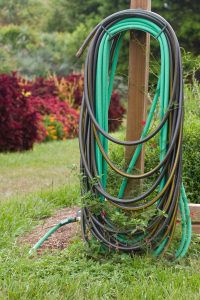
A common site in the garden – multiple hoses pieced together. Be aware of galvanic corrosion! Credit: Tyler Jones, UF/IFAS.
It was the best of times, it was the worst of times. It was a nice day in the garden, but when you go to disconnect the hose, it is somehow stuck to the spigot, connector, or other hose. You go and get the pliers, but the hose just doesn’t budge. If this has happened to you, then you now know of the chemical reaction that can occur between aluminum and brass hose fittings. Hopefully, this is just two hoses stuck together, and you can cut them off and replace them with new ends. If the hose is connected to the spigot and won’t budge, you may want to contact a plumber before you create a bigger problem.
While knowing the name of this chemical reaction, galvanic corrosion, doesn’t help you while you curse these hose fittings, it is yet another scientific discovery in the garden. Galvanic corrosion occurs when two dissimilar metals are in electrical contact with each other in the presence of an electrolyte. The metals must be dissimilar in their electrochemical voltage. I know, you just want to disconnect hoses, not learn physics, but this stuff is interesting! Basically, aluminum is pretty reactive, especially when joined up with brass, bronze, copper, and even stainless steel. In the case of our hoses, the water acts as an electrolyte thanks to the calcium present in our delicious and abundant limestone aquifer groundwater. You put all these together and, bazinga, you have the aluminum hose end corroded into your brass hose end so strongly that no pliers will ever unlock them.
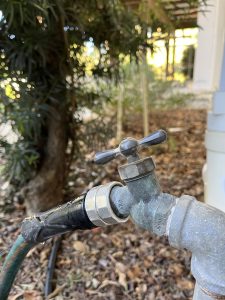
This won’t work out well for too long! Aluminum hose end on a brass spigot will lead to galvanic corrosion. Credit: Mark Tancig, UF/IFAS.
So, what do you do to prevent this? The easiest way to prevent galvanic corrosion from ruining your nice day in the garden is to only purchase products with the same material as your spigots. Brass spigots, hose bibs, and hose ends have been the industry standard, while aluminum hose endings seem to be more of a recent occurrence. Aluminum is cheaper, so you can understand why the hose companies would be interested in switching. If you already have two different materials, first check and see if you can get them disconnected. If not, start purchasing new hoses that match the spigot and/or connector. If you can get them disconnected, one method to prevent galvanic corrosion is to just disconnect them regularly to avoid them fusing. Not sure if you’ll remember? You can also use a plastic connector between the hoses to make sure the two metals don’t touch each other or switch out the aluminum hose ends with replacement brass or plastic ends, found at most hardware stores.
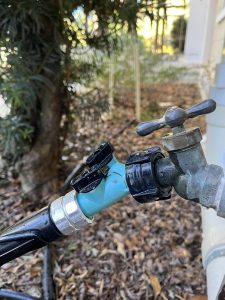
A quick fix is to place a plastic connector between the dissimilar metals. Credit: Mark Tancig, UF/IFAS.
Now that you’ve learned about galvanic corrosion, it’s time to get back to gardening. Good luck with those hoses! If you have other gardening questions, please contact your local extension office.

by Joshua Criss | Nov 6, 2025
Another North Florida winter is here! With that comes a new plants from leafy greens to snapdragons. It also means the inevitable freeze is on the way. It is prudent for all gardeners to review what needs to be done to protect your non-freeze hardy plants.
Hardiness Zones
Before we get into what actions you may need to take, let’s examine plant hardiness zones. These are geographic areas created by the US Department of Agriculture defined by their average extreme minimal temperature. In the Panhandle these are zones 8b through 9b. In winter we will likely see low temps between 15 – 30 degrees depending on your zone. Sourcing plants appropriate for your zone can mitigate quite a bit of cold damage in your landscape. If you like plants susceptible to the cold, you can interplant them to add a little protection.
Microclimates
Find and utilize your yard’s microclimates. Areas under larger trees are likely to remain warmer in the winter. This is also true behind a windbreak, or near a structure with high sun exposure. Look around your yard and plant any cold sensitive plants in these areas.
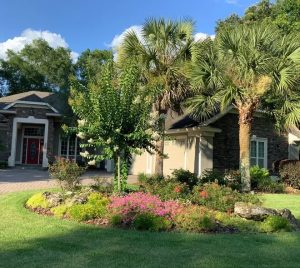
This area is likely to have multiple microclimates. UF/IFAS Photo
Full Season Plant Care
Cold protection begins with warm season plant care. Pay close attention to the irrigation and fertilization needs of your landscape plants. Apply these properly to ensure stress free plants moving into the colder months as these will perform better as the mercury begins to drop.
Imminent Freeze Actions
Ok, now that everything is planned, we know our microclimates, and we’ve cared for our landscape through the year let’s see what can be done when a freeze is imminent.
Water the morning prior to a freeze event. Wet soils retain warmth better than dry. That heat will be re-radiated through the freezing night keeping your plant slightly warmer. Adding some mulch will aid this effort. Watering again the next day will break any ice formed in the soil. Keep in mind that prolonged saturation could be detrimental to root systems. Scout your plants regularly after using this strategy to ensure plant health.
Protect potted plants by bringing them indoors. Those that are too big to move should be padded with extra mulch, and clustered together when possible. Make sure to move them back in place when the warmth returns.
For those trees with graft points (i.e. Citrus), tree wraps may be used as protection. If you don’t have these, pile mulch around the base of the tree to insulate the graft. The idea here being that even if the branches above the graft succumb to the cold, the tree can rebranch above the graft thus keeping the desired fruit of that tree.
Finally, cover your plants. Covers are more useful for frost than freezing temps but are better than direct exposure to cold air. Keep these off the plant’s foliage while ensuring they reach all the way to the ground. Think ghosts over lollipops. Taking them to the ground will capture any heat radiated out of the soil overnight. The addition of lights underneath the cover can help keep that area a little warmer. Be very cautious when doing this as too much heat under the cover could be dangerous.
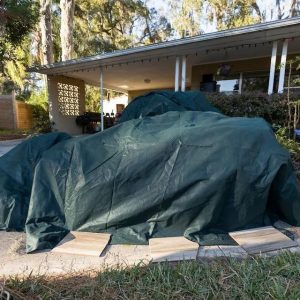
Plants covered above the foliage, and to the ground. UF/IFAS Photo
You may see some nurseries apply irrigation via sprinklers through the freeze as protection. While this method does work, it requires some specialty equipment. Additionally, you’ll need to apply the water prior to the freeze setting in and continue until the temps return. It not a practical solution for homeowners.
Once the cold passes, keep an eye on your plants. Wait until you see new growth before pruning damaged plant tissue. If in doubt you can slightly scrape the bark. If the cambium beneath the scrape is green, it is still alive.
For more information on cold protection or any other horticultural topic contact you local UF/IFAS Extension office.

by Lauren Goldsby | Oct 23, 2025
One of my favorite ways to spend the morning lately is in the garden drinking my coffee. There’s no intended purpose, other than to look and see what I can find. I always end up finding something interesting! Scouting your garden does not have to be a formal process, but it is more effective when done regularly. This can help to avoid the “it happened overnight!” phenomenon that we hear frequently. Pests and diseases do not typically cause damage that quickly. Regular scouting helps you notice small symptoms before they become big problems. Training your brain to notice these small changes happens over time with your scouting, but just like any new skill, you need to practice! Give it a chance and watch the tiny world open up around you. Come scout the garden and see what we find.
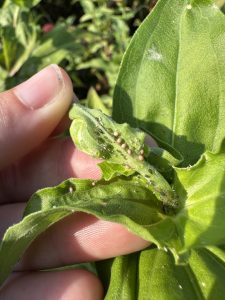
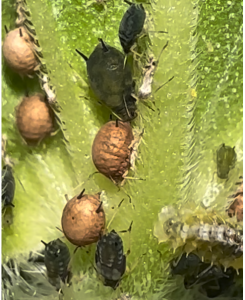
In this photo you can see a close up of the mummified vs. regular aphids. For more information on parasitic wasps and other natural enemies see: https://edis.ifas.ufl.edu/publication/IN120
I noticed some wrinkled leaves on the new growth of a zinnia. Wrinkled new growth can be a sign that a piercing-sucking insect is causing damage. Turning over the leaves revealed aphids, a common culprit on zinnia. In this photo we can see aphids in a few different life stages. Importantly, we also see that some of the aphids are serving as food for beneficial insects. These mummified aphids are the ones you see with tan, golden bodies that are larger and more round. A small, parasitic wasp larvae, is living inside the aphids body– using it for protection and food until it is ready to emerge. These are good signs of a healthy working ecosystem and they can help keep aphid populations in control. This helps me to know that there are aphids in my zinnias, but that I don’t need to do anything about them right now. Natural predators are at work and can be more effective than chemical applications at this time. If you need help identifying insects in your garden, reach out to your local extension office. Not all insects on our plants are causing harm; and some are actually helping decrease pests.
I don’t always find pests in the garden. Sometimes I realize the irrigation timer was turned off or I take a really pretty picture for my instagram story (see below). These are still wins in my book! Remember that your landscape is an entire ecosystem and you are a part of it. It’s a great practice to walk around and take an intentional look at your plants when you get the chance, you may see something cool!

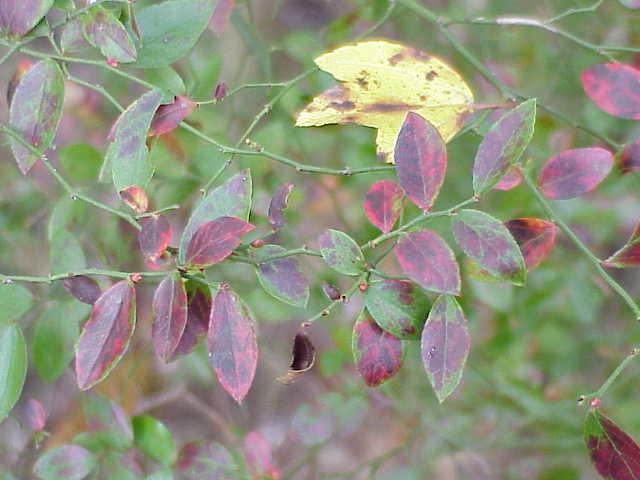
by Beth Bolles | Sep 18, 2025
Many gardeners enjoy plants that attract butterflies and there is no shortage of beautiful flowering plants to supply nectar for all our pollinators. One critical part of making habitat for butterflies that we may need to improve upon is supplying plenty of host plants for butterfly development. While we enjoy the flight of a butterfly through our garden, we really want to offer features that keeps them around.
Your landscape likely includes a few host plants and maybe you even have a citrus tree or plant parsley every season. What many people don’t realize is how many native trees serve as host plants for butterflies. Some of these plants like specific environments while others can grow in a wide variety of habitats.
The Black cherry (Prunus serotina) and Cherry laurel (Prunus caroliniana) serve as host to a large number of butterflies. A more well know species that uses the native cherries for development is the Tiger swallowtail. Although we might consider these trees weedy, they can serve as hosts to hundreds of species of butterflies and moths along with providing berries for wildlife. The black cherry will be deciduous while the cherry laurel is evergreen. Both have flowers in late winter or early spring. Just be aware that the cherry laurel fruit can have some toxicity in different developmental stages.

Yellow form of the Tiger Swallowtail. Some females can also have mostly black coloration to prevent predation. Photo: Beth Bolles, UF IFAS Extension Escambia County.
The Winged elm (Ulmus alata) is gaining in popularity as a landscape tree. The Question mark butterfly will lay eggs on plants under the elm and then caterpillars crawl up to feed on elm leaves. The reason we don’t see this butterfly on flowers as much is that it also feeds on manures, carrion, and rotting fruit. Resting butterflies have wing patterns that make them look like leaves.
If you have a site with moist soil or can supply routine moisture, consider the Sweet bay magnolia (Magnolia virginiana). It will attract the Tiger, Palamedes, and Spicebush swallowtails for development. Flowers on the tree are not as large as those on Southern magnolia but you still have similar appearance and even a pleasant fragrance.
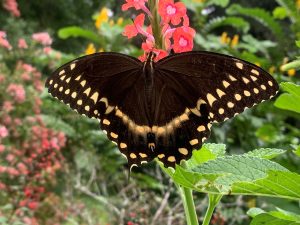
Palamedes swallowtail butterfly feeding on a porterweed. Photo by Beth Bolles, UF IFAS Extension Escambia County.
A couple of understory trees are the Pawpaw (Asimina triloba) and Sparkleberry (Vaccinium arboreum). Look for the Zebra swallowtail to find the Pawpaw while the sparkleberry will serve as host to hairstreak butterflies.

Pawpaw also offers delicious fruit. Photo by Beth Bolles, UF IFAS Extension Escambia County.
Even though landscapes may have limited spaces for every host plant, we can preserve some spaces around borders for native trees. These plants will make a positive impact for butterflies and pollinators.




















